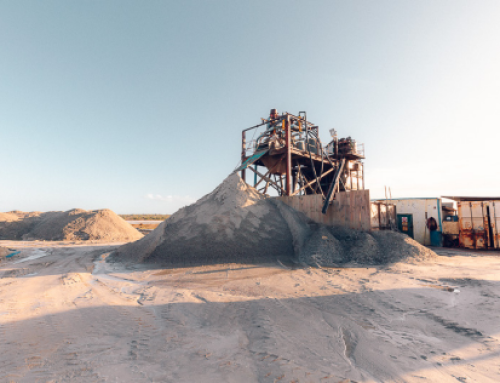Gypsum may be best known as an ingredient of wallboard, but its many other uses extend far beyond this application. Gypsum is an effective soil amendment that adds calcium and sulphur while decreasing acidity levels, making gypsum ideal for farms, gardens and lawns alike.
Soil lightening lightens clay soils, producing looser aggregates that are easier to work with, as well as improving response to other inputs – specifically fertilisers.
Function
Gypsum improves soil structure by facilitating the movement of water and nutrients more freely through it, while increasing permeability by dispersing clay particles into smaller fragments that break more easily through them.
Increased access to calcium for plants. Calcium ions are readily accessible to plant roots when percolated through to the lower soil layers where gypsum was applied, unlike lime (CaCO4) which only percolates to surface roots and thus cannot provide as much benefit.
Calcium ensures adequate uptake of most other nutrients, particularly micro-nutrients. (Calcium helps activate biochemical mechanisms by which roots absorb most other nutrients). Furthermore, calcium regulates balances non-essential trace elements like iron manganese and zinc while keeping their levels from reaching excessively high levels within plants.
Gypsum Can Reduce Soil Runoff and Erosion
Gypsum helps protect farm fields by keeping soluble phosphorus (P) from leaving in water runoff that pollutes lakes and rivers, contributing to poor water quality in lakes and rivers. Furthermore, it can help decrease erosion by increasing soil permeability; decreasing speed at which water moves through it thus decreasing amount of escape into lakes and rivers.
Advantages
Gypsum is an outstanding soil amendment. It helps prevent field ponding, soil surface sealing or crusting and seed emergence while aiding early plant growth, improving water infiltration and hydraulic conductivity of the soil – qualities particularly advantageous during drought conditions. Gypsum also decreases wind and water erosion and dust problems while helping control pesticide and nutrient residue loss from surface soil layers into lakes and rivers.
Alfalfa and soybean yields benefit significantly, as does water efficiency of crops due to enhanced water penetration and root uptake of nutrients.
Recycled gypsum is an economical source of calcium and sulphur. By eliminating the need to mine from geologic deposits and saving landfill space, recycled gypsum provides an economical source of these vital elements. Used together with organic material, recycled gypsum helps prevent burn-out of organic matter in soil while improving structure in clay soils and decreasing heavy metal toxicity toxicity levels. Furthermore, recycled gypsum acts as an ideal base material upon which other beneficial amendments may be added later.
Reduce sodium leaching from irrigation water with high salt concentration and prevent the buildup of salt in lower soil horizons due to rising sodium levels combined with swelling clay particles, while simultaneously decreasing losses of soluble phosphorus from fields.
Applications
Gypsum is an affordable and versatile soil amendment. Available as either finely crushed product that can be spread manually or integrated with soil using tilling equipment, or liquid preparation that can be administered via sprayer rigs, fertigation injection systems and center pivot irrigation, it comes in both forms.
Gypsum can enhance acid soils beyond what lime can. It helps break up compacted soil, improve water penetration and aeration of the topsoil, decrease crusting resistance for plowing pans, allowing deeper rooting (Shainberg et al. 1989; Smyth and Cravo 1992), as well as replace toxic aluminum ions in clay soils with nontoxic sulfate ions (which won’t harm plants).
Gypsum improves soil permeability to reduce erosion during rainstorms and decrease the amount of phosphorus moving out of fields, making it an effective choice when there are high sodium levels or swelling clays present in the soil. Furthermore, it increases absorption capacity so as to prevent waterlogging of fields.
Gypsum can also be used to combat sulfur deficiency. Sulfur is essential for protein synthesis in legume roots and nodule formation on legumes; Gypsum provides it in an easily available form that moves quickly from surface to soil level.
Cost
Gypsum (Calcium Sulfate Dihydrate – CaSO4 * 2H2O), commonly referred to as Gypsum is a natural mineral found in sedimentary rock that has been utilized as an agricultural amendment and soil conditioner for over 200 years. George Washington and Benjamin Franklin advocated using Gypsum as an agricultural amendment and soil conditioner. George used Gypsum himself to maintain the proper chemical balance among soil, water, crops and animals while it provided inexpensive fertilization that prevented sodicity, improved physical structure of soil physical structure while simultaneously increasing drainage while stabilizing organic matter while increasing nitrogen retention within crops.
High-magnesium sodic clays can ‘flocculate’ and break down, improving their physical structure while permitting air and water movement. Furthermore, this technique helps reclaim sodic soils by dissolving sodium into calcium instead of leaving the ground unprotected and sodic.
Soil conditioner can be applied directly to the soil or mixed into irrigation water, ground into fine powder form and mixed in prior to planting or after harvest of hay fields. While beneficial for any crop, pasture crops often benefit most as the bulk density is decreased making tilling easier while plants respond more readily to other inputs like fertilizer and/or other inputs like no-till management inputs such as fertilizers. It can even serve as an effective pretreatment for no-till management by increasing soil permeability.



